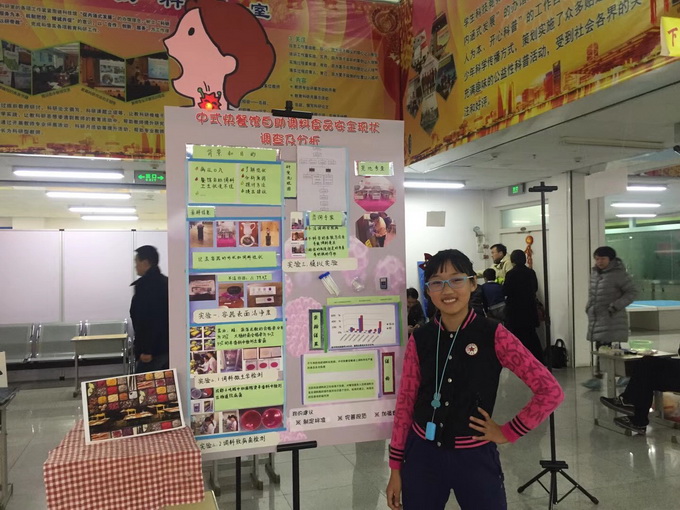
Wang Sihan, Wang Peiyuan and Feng Liangda studied plastic wrap.
[Yellow axis and white axis plastic wrap should be distinguished]
When summer comes, watermelon has become a weapon for many families to relieve summer heat. Many people may have had this experience: watermelon can’t be eaten, wrapped in plastic wrap and put in the refrigerator for the next meal. Have you ever noticed the color of the shaft core of the plastic wrap used at home? Feng Liangda from Beijing No.2 Experimental Primary School found that the core of plastic wrap at home was white; And the core of the plastic wrap used in the watermelon stall near home is yellow. What’s the difference between plastic wrap with different shaft core colors? Which plastic wrap is better? Feng Liangda and his friends Wang Peiyuan and Wang Sihan launched an investigation together.
Under the guidance of parents and teachers, the three people learned through reading the materials that the raw material of white core plastic wrap is polyethylene PE, and the raw material of yellow core plastic wrap is PVC. As early as 2009, China issued the national standard of "Plastic Self-adhesive cling film for food", which covered the types of PEPVC cling film, and mentioned that "PVC cling film is only suitable for packaging fresh food such as vegetables and fruits that are not directly imported".
Three people used the equipment of the school and Xicheng Science and Technology Museum to carry out the combustion experiment, which verified the difference of the two materials. It was found that the solution that absorbed the gas released by the combustion of the yellow shaft core was acidic, and after adding silver nitrate, the solution produced white precipitate, which indicated that the yellow shaft core plastic wrap contained chlorine. The solution that absorbed the gas released by the combustion of the white shaft core was neutral, and there was no precipitation after adding silver nitrate, indicating that it did not contain chlorine.
So, what is the actual use of different types of plastic wrap? The three people also chose 14 large supermarkets, 22 small supermarkets, 10 mobile stalls, 7 farmers’ markets and 27 families for investigation. The results showed that the utilization rate of white-axis plastic wrap in large supermarkets was 57.1%; In small supermarkets, mobile stalls and farmers’ markets, the utilization rate of white-axis plastic wrap is 0; 85.2% private families use white-axis plastic wrap.
At the same time, although most regular supermarkets can use plastic wrap correctly, the staff are not clear about the material specifications; Even among families with high qualified rate, only 59.3% of them know the requirements for proper use, and 40.7% know the material of plastic wrap. "It shows that many people don’t know what kind of plastic wrap to use, and many times they don’t notice that the merchants use yellow-core PVC plastic wrap for them."
To this end, the research team suggested that in the packaging of food plastic wrap, in addition to the material of plastic wrap, it is also necessary to indicate the application scope of plastic wrap, and at the same time, the temperature range of safe heating of different plastic wrap should be clarified to remind merchants and consumers to standardize their use. In addition, we should strengthen the inspection of food cling film for small supermarkets, farmers’ markets, fruit merchants and mobile food stalls, and formulate punishment measures for illegal use of cling film; At the same time, strengthen publicity, such as posting posters of plastic wrap at bus stops, subways, networks, supermarkets, shopping malls, etc., to publicize the differences in the use of plastic wrap, and promote the standardized production of plastic wrap through consumption supervision.
[Express envelopes cannot be "one size fits all"]
Li Xinyang, from the middle school affiliated to Beijing Normal University, is a "drama-chasing" expert. She always places an order online for any performance she wants to see. But every time she opens the express envelope, she will find that the big express envelope is a bit "overqualified" compared with the small performance notes.

After paying attention to this issue, Li Xinyang found that the phenomenon of "small content and big envelope" is not uncommon. In addition to her own performance tickets, when the credit card applied by her mother was delivered, it was also packed in a big express envelope. In fact, the waste of disposable products caused by express packaging has been paid attention to. According to public reports, in 2016, the number of materials used in express packaging in China was staggering-according to statistics, in 2016, about 3.2 billion woven bags, about 6.8 billion plastic bags, 3.7 billion packing boxes and 330 million rolls of adhesive tape were consumed … But in contrast, the unreasonable use of envelopes has not attracted the attention of society.
What is the current situation of using express envelopes over size? What are the reasons behind it? How to solve it? After communicating with the instructor, Li Xinyang decided to take this as his research topic.
Through the questionnaire survey, Li Xinyang found that 97.16% of the public had mailed the tickets by express mail, and 90.34% of them bought the tickets through the Internet. Express mail has become the first choice of the public. In addition, the use of express envelopes by the public is not limited to sending printed materials. In the process of using express envelopes, 59.09% of the public mailed documents, 55.11% of the public mailed invoices, 46.02% of the public mailed certificates, 39.77% of the public mailed books, 32.95% of the public mailed tickets for performances, 17.61% of the public mailed greeting cards, and 39.77% of them mailed cards.
The courier company mainly provides 324X229mm No.9 envelope; The actual measurement shows that the size of the general performance ticket is 80X200mm, and only the No.5 envelope of 220X110mm is needed. The size of the credit card is 54.0X85.6mm, and only the No.3 envelope of 176X125mm is needed. According to the survey, nearly 40% of the respondents think that the size of the express envelope is too large, and over 60% think that the size of the express envelope should be based on demand.
In the investigation of the mailer, Li Xinyang learned that if five different types of envelopes are required to be carried, most of the postal and courier parties said that they would be troubled by carrying trouble and increasing the load.
On the basis of investigation, Li Xinyang put forward his own suggestions. She believes that the State Postal Administration should issue technical specifications for the express delivery industry. For express delivery envelope manufacturers, they can design and produce express delivery envelopes with different patterns according to the different needs of the public while ensuring the basic specifications of express delivery envelopes. In addition, she suggested that courier companies should provide personalized services and prepare courier envelopes with reasonable sizes. For example, there are many printed materials such as documents mailed by enterprises, and envelope No.9 can be the main one; Prepare the No.5 express envelope suitable for the theater and ticketing business network. You can also increase the size of the pick-up in the courier company APP or WeChat smart applet, so that the courier can prepare the courier envelope with a convenient size in advance and reduce the burden on the courier.
At the same time, in her opinion, the cost of large envelopes and small envelopes should be different; If the public prepares their own envelopes, the mailing fee can be appropriately reduced. "I hope to attract more public attention to this phenomenon and work together to make due contributions to environmental protection."
[Restaurant self-service seasoning safety is worrying]
Liu Yifei from Beijing No.2 Experimental Primary School is a little gourmet, especially fond of rice noodles and barbecues. After eating too much, she began to find that in order to meet the different tastes of customers, such restaurants would equip their tables with self-help public seasonings such as Chili oil, soy sauce and vinegar. Once, after seeing the report that the hygienic condition of street stalls was worrying, she came up with the idea of investigating the self-service spices in restaurants.

After searching on the Internet, it is known that the microbial detection of single seasoning such as soy sauce and vinegar on the dining table is carried out according to the state standard of pre-packaging before unpacking; However, in the current National Standards for Food Safety, there is no hygienic evaluation standard for spicy spices and mixed seasonings such as pepper and salt and Chili sauce. After consulting experts from the Food and Drug Administration, Liu Yifei learned that for condiments on the table, the national regulations only clearly pointed out that self-service condiments could not detect pathogenic microorganisms, but more detailed microbial inspection standards were still lacking; At present, there is no corresponding operating standard for the sub-packaging of soy sauce vinegar.
So, is the seasoning easy to breed microorganisms? After consulting the experts in xuanwu hospital Bacteriology Room, she learned that the seasoning bottles in restaurants are frequently used, and if they are not cleaned and disinfected regularly, they will probably become "invisible killers" that endanger people’s health. Among them, there are three reasons that may lead to the pollution of spices: on the one hand, unclean packaging operation will lead to the pollution of spices at the source; On the other hand, the containers containing spices in restaurants are not clean, not cleaned and disinfected according to relevant regulations, and the sources of customers are complex, which leads to secondary pollution of spices; In addition, the self-service seasoning does not follow the preservation method stipulated by the manufacturer, and it is easy to cause the growth of pathogenic microorganisms in open containers, at room temperature and for a long time.
His own sampling experiment also confirmed the expert’s statement. Liu Yifei tested 24 seasonings from 8 restaurants: 8 sauces, the qualified rate of total colonies was 25%, and the qualified rate of Escherichia coli was 50%; Eight vinegar samples, the qualified rate of the total number of colonies was 25%, and the qualified rate of Escherichia coli was 50%. Intestinal pathogens were detected in one vinegar sample. Due to the lack of national hygiene standards, it is impossible to judge whether it belongs to the normal range, but mold was detected in 50% of spices, and intestinal pathogens were detected in one spice (Chili sauce).
In this regard, Liu Yifei suggested that relevant departments should further improve the scope of food microbial detection of seasonings, and include those that do not have hygienic standards at present, such as spicy spices and mixed seasonings, into the detection targets to supplement the standards; At the same time, the operating specifications, seasoning storage methods, container standardization and other aspects of the restaurant service personnel’s sub-packaging of spices into small containers will be included in the "Food Safety Operating Specifications for Catering Services", and supervision will be strengthened to promote the self-management and self-control of the catering service industry.